Peabody Museum of Salem
|
Peabody Museum of Salem | |
|
View of East India Marine Hall exterior, 2013 | |
  | |
| Location | Essex St., Salem, Massachusetts |
|---|---|
| Coordinates | 42°31′18″N 70°53′36″W / 42.52167°N 70.89333°WCoordinates: 42°31′18″N 70°53′36″W / 42.52167°N 70.89333°W |
| Area | 1 acre (0.40 ha) |
| Built | 1825 |
| NRHP reference # | 66000783[1] |
| Significant dates | |
| Added to NRHP | October 15, 1966 |
| Designated NHL | December 21, 1965 |
The Peabody Museum of Salem (1915–1992), formerly the Peabody Academy of Science (1865–1915), was a museum and antiquarian society based in Salem, Massachusetts.[2] The academy was organized in part as a successor to the East India Marine Society (founded 1799), which had become moribund but held a large collection of maritime materials in a museum collection at the East India Marine Hall, built in 1825 on Essex Street. The Peabody Museum was merged with the Essex Institute to form the Peabody Essex Museum in 1992. The East India Marine Hall, now embedded within the latter's modern structure, was designated a National Historic Landmark in 1965 in recognition of this heritage, which represents the nation's oldest continuously-operating museum collection.
History
The Peabody Academy of Science (1868–1915), successor to the East India Marine Society, "was organized in 1868, having received funds ... from George Peabody of London ... for the 'promotion of science and useful knowledge in the county of Essex.'"[3] It was incorporated by "Asa Gray, of Cambridge, William C. Endicott, of Salem, George Peabody Russell, of Salem, Othniel C. Marsh, of New Haven, ... Henry Wheatland, of Salem, Abner C. Goodell, junior, of Salem, James R. Nichols, of Haverhill, ... Henry C. Perkins, of Newburyport, and S. Endicott Peabody.[4]
The academy maintained a museum that displayed animals, fossils, minerals, and plants, as well as ethnological artifacts such as weapons, costume, tools, statuary, and musical instruments.[5] In 1915 the Academy changed its name to the "Peabody Museum of Salem."[6]
As of 1949 the museum organized its holdings into three departments: ethnology, maritime history, and natural history. The museum's ethnology division included specimens from Hawaii, Japan, Marquesas Islands, and New Zealand.[7]
The museum displayed its collections in the East India Marine Hall, expanded in 1953 with the Crowninshield Galleries.[8] Museum staff included Ernest Stanley Dodge[9] and Walter Muir Whitehill.[10]
In 1984 the China Trade Museum of Milton, Massachusetts, merged with the Peabody Museum.[11][12] In 1992 the Peabody Museum merged with the Essex Institute to form the Peabody Essex Museum.[13]
East India Marine Hall
The East India Marine Hall was built in 1824–25 for the East India Marine Society to house its collection. Design of the building has most recently been ascribed to Thomas Waldron Sumner. It stands on the south side of Essex Street and is now integrated into the body of the Peabody Essex Museum. As built, it was a two-story structure, faced in granite on the front (Essex Street facade), and brick on the sides, measuring about 45 by 100 feet (14 m × 30 m). The main facade has been preserved; it has six rectangular bays on the main floor and seven tall round-arch windows on the second level. The gable pediment is fully enclosed, with a round window in the tympanum.[14]
The interior of the building has been repeatedly altered over the years, losing a significant amount of original detail in the process. The first floor, which was originally occupied by retail businesses, was adapted as a museum space in 1867–69, following its acquisition by the Peabody Academy of Science. As part of this alteration, entrances on the main facade were closed off, and new entrances were added to the east and west. The first floor has since been completely integrated into the newer facilities built by the Peabody Essex Museum in the 2000s. The upper level of the hall, designed as a ballroom and auditorium space, has always been retained as a large open gallery, but lost a significant amount of historic fabric in the 1860s alterations.[14]
The hall was designated a National Historic Landmark in 1965, and listed on the National Register of Historic Places in 1966, in recognition for its unique place as one of the oldest continuously-used museum spaces in the United States.[1][14][15]
See also
- American Neptune, a journal published by the museum[8]
- List of National Historic Landmarks in Massachusetts
- National Register of Historic Places listings in Salem, Massachusetts
References
- 1 2 National Park Service (2010-07-09). "National Register Information System". National Register of Historic Places. National Park Service.
- ↑ "An Act To Change The Name Of The Trustees Of The Peabody Academy Of Science To Peabody Museum Of Salem And To Authorize Said Corporation To Hold Additional Real And Personal Estate", Acts and resolves passed by the General Court of Massachusetts, 1915
- ↑ Charles Edward Trow (1905). Old Shipmasters of Salem. G.P. Putnam's Sons.
- ↑ An act to incorporate the Trustees of the Peabody Academy of Science, 1868
- ↑ Visitor's Catalogue of the Museum of the Peabody Academy of Science. Salem, Mass.: Peabody Academy of Science. 1879.
- ↑ "An Act to Change the Name of the Trustees of the Peabody Academy of Science to Peabody Museum of Salem", Acts and Resolves Passed by the General Court of Massachusetts, 1915
- ↑ Ernest S. Dodge (1949). "Ethnology Department". Handbook to the Collections of the Peabody Museum of Salem. pp. 1–21.
- 1 2 Walter Muir Whitehill (1962), "Peabody Museum of Salem", Independent historical societies: an enquiry into their research and publication functions and their financial future, Boston Athenæum, OL 5873465M
- ↑ "Ernest Stanley Dodge". WorldCat.
- ↑ "Walter Muir Whitehill". Boston Athenaeum.
- ↑ Peter Fetchko (1987). "New England Voyages: A New Approach to the Interpretation of the Collections of the Peabody Museum of Salem". Pacific Arts Newsletter. Pacific Arts Association (25). JSTOR 23409002.
- ↑ "Asian Export Art". Peabody Essex Museum.
- ↑ "Museum history". Peabody Essex Museum. Retrieved 1 February 2011.
- 1 2 3 "NHL nomination for Peabody Museum of Salem". National Park Service. Retrieved 2014-11-14.
- ↑ "NHL summary for Peabody Museum of Salem". National Park Service. Archived from the original on 2014-07-26. Retrieved 2014-11-14.
Images
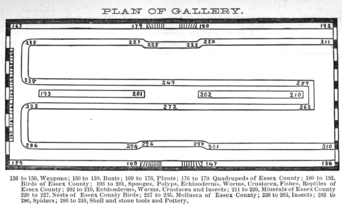 Map of part of the Museum of the Peabody Academy of Science, 1879
Map of part of the Museum of the Peabody Academy of Science, 1879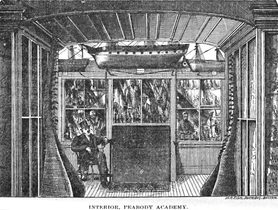 Interior, Peabody Academy, 1880
Interior, Peabody Academy, 1880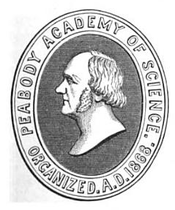 Emblem of the Peabody Academy of Science, 19th century
Emblem of the Peabody Academy of Science, 19th century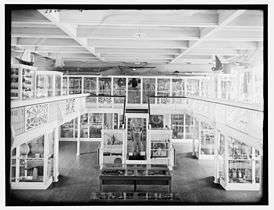 Peabody Museum, Salem, Massachusetts, circa 1910s
Peabody Museum, Salem, Massachusetts, circa 1910s Peabody Museum Marine Room, circa 1920
Peabody Museum Marine Room, circa 1920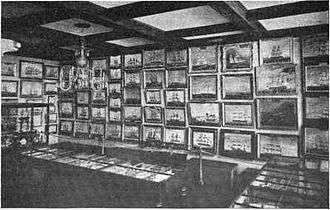 Peabody Museum Marine Room, circa 1920
Peabody Museum Marine Room, circa 1920 Peabody Museum half hulls built between 1809-1870 of Salem ships
Peabody Museum half hulls built between 1809-1870 of Salem ships Logo, 1921
Logo, 1921
Further reading
Issued by the museum
- Peabody Academy of Science (1867–1887), Annual reports, Salem
- Memoirs of the Peabody Academy of Science, Salem, Mass., 1869–1886
- Edward Sylvester Morse (1900), Brief Sketch of the Peabody Academy of Science
- Guide to the Peabody Museum. Salem, MA. 1916.
- One Hundredth Anniversary of the Building of 'Cleopatra's Barge' 1816-1916: Catalog of the commemorative exhibition held at the Peabody Museum ... July 17-September 30, 1916. Peabody Museum of Salem. 1916.
- Hawaiian Portion of the Polynesian Collections. 1920.
- John Robinson (1921), Marine Room, OCLC 1147254
- Guide to the Peabody Museum. Salem, MA. 1927. (fulltext via Hathi Trust)
- Guide to the Peabody Museum. Salem, MA. 1937. (fulltext via Hathi Trust)
- George Augustus Peabody (1937). John C. Phillips, ed. South American journals, 1858-1859. (fulltext via Hathi Trust)
- Ernest Stanley Dodge (1939). Marquesas Islands Collection. (fulltext via Hathi Trust)
- Ernest Stanley Dodge (1941). New Zealand Maori Collection. (fulltext via Hathi Trust)
- Handbook to the Collections of the Peabody Museum of Salem. 1949.
- Ethnology, pages 1–21
- Maritime History, pages 22–44
- Natural History, page 45+
- Walter Muir Whitehill (1949). East India Marine Society and the Peabody Museum of Salem; a Sesquicentennial History. Salem, Mass.: Peabody Museum. (fulltext via Hathi Trust)
About the museum
- T.F. Hunt (1880), "Peabody Academy of Science", Visitor's Guide to Salem, Salem, Mass.: H.P. Ives, OCLC 10361879
- Henry Phillips, Jr. (1883). "Brief Account of the More Important Public Collections of American Archæology in the United States". Proceedings of the American Philosophical Society. 21.
Peabody Academy of Science, Salem, Mass.
- "Peabody Academy of Science". Salem Directory. Boston: Sampson, Murdock & Co. 1886.
- "Salem, Mass.: Peabody Academy of Science". Handbook of Learned Societies and Institutions: America. Carnegie Institution of Washington. 1908.
- "Directory of American Museums: Massachusetts: Salem: Peabody Academy of Science", Bulletin of the Buffalo Society of Natural Sciences, New York, 10, 1910–1912
- "Peabody Museum of Salem, Massachusetts", Proceedings of the American Association of Museums, 1911
- Norman R. Bennett, George E. Brooks, Alan R. Booth. Materials for African History in the Peabody Museum and Essex Institute. African Studies Bulletin, Vol. 5, No. 3 (Oct., 1962), pp. 13–22
- Ernest S. Dodge (1972). "William Lockerby Manuscript in the Peabody Museum of Salem". Journal of Pacific History. 7: 182–188. doi:10.1080/00223347208572210. JSTOR 25168102.
Fijian sandalwood trader
- Susan Stedman (1976). "Peabody Museum of Salem". African Arts. University of California. 10. JSTOR 3335256.
- Allen Kent; et al., eds. (1977). "Peabody Museum of Salem". Encyclopedia of Library and Information Science. 21. New York: Marcel Dekker. ISBN 978-0-8247-2021-6.
- William L. Phippen (1984). "Summary of the Pacific Collection Inventory at the Peabody Museum of Salem, Massachusetts". Pacific Arts Newsletter (18). JSTOR 23411167.
- Robert P. Spindler, Gregor Trinkaus-Randall, Prudence Backman. Format for Cooperation: Cooperative Collection Registers at the Peabody Museum of Salem and the Essex Institute. The American Archivist, Vol. 51, No. 1/2 (Winter - Spring, 1988), pp. 115–119
External links
| Wikimedia Commons has media related to Peabody Museum of Salem. |
| Wikimedia Commons has media related to Peabody Academy of Science. |
- Digital Public Library of America. Items related to Peabody Academy of Science, Salem and Peabody Museum, Salem, various dates